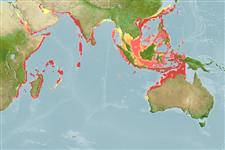Environment: milieu / climate zone / depth range / distribution range
पारिस्थितिकी
समुद्री प्रवाल-भित्ति संयुक्त; गहराई सीमा 1 - 110 m (Ref. 89707). Tropical; 30°N - 27°S, 33°E - 136°E
Indian Ocean: Persian Gulf to southern Mozambique and eastward to Western Australia. Not known from the Red Sea.
Length at first maturity / आकार / वज़न / Age
Maturity: Lm ? range ? - 50 cm
Max length : 100.0 cm TL पुल्लिंग / अलिंग; (Ref. 5222); common length : 75.0 cm TL पुल्लिंग / अलिंग; (Ref. 5450); अधिकतम प्रकाशित वज़न: 9.0 kg (Ref. 3132)
पृष्ठीय रीढ़ (सम्पूर्ण): 11; पृष्ठीय सौफट रेज़ (सम्पूर्ण): 15-17; गुदा कांटा 3; ऐनल सौफट रेज़: 8. Distinguished by the following characteristics: color is dark purplish gray with scattered irregular whitish spots and blotches which are faint or absent in preserved fish; ctenoid body scales except cycloid dorsoanteriorly below anterior half of spinous dorsal fin, thorax, abdomen and above anterior anal fin; body with numerous auxiliary scales; greatest depth of body 2.5-3.0 in SL; slightly emarginate to truncate caudal fin; short pelvic fins, 1.7-2.3 in head length (Ref. 90102); head length 2.4-2.7 times in SL; distinctly convex interorbital, slightly convex dorsal head profile; subangular preopercle, shallow notch just above the angle, serrae at angle not or slightly enlarged; upper edge of operculum straight; posterior nostrils of adults is twice the size of anterior nostrils; maxilla reaches vertical at rear edge of eye or thereabouts; ventral edge of maxilla of adults with distinct step distally; 2 rows of teeth on midlateral part of lower jaw (Ref. 89707).
Inhabit clear to turbid water in shallow as well as deep water (Ref. 4787). Juveniles are found in inshore coral reefs (Ref. 5222). They feed in water to more than 100 m depth (Ref. 27275). It has been suggested that juveniles mimic the herbivorous damselfish Neopomacentrus sindensis, presumably to get closer to their unsuspecting prey (Ref. 5222, 9710). Feed on small fishes and crabs. Probably spawn during restricted periods and form aggregations when doing so (Ref. 27352). Eggs and early larvae are probably pelagic (Ref. 6390). Solitary (Ref 90102).
Life cycle and mating behavior
परिपक्व अवधि | पुनरुत्पत्ति | मछलीऔ का अंडे देना | अंडे | Fecundity | लार्वा
Rock cod are protogynous hermaphrodites.
Heemstra, P.C. and J.E. Randall, 1993. FAO Species Catalogue. Vol. 16. Groupers of the world (family Serranidae, subfamily Epinephelinae). An annotated and illustrated catalogue of the grouper, rockcod, hind, coral grouper and lyretail species known to date. Rome: FAO. FAO Fish. Synop. 125(16):382 p. (Ref. 5222)
IUCN Red List Status (Ref. 130435)
Threat to humans
Harmless
Human uses
मात्स्यिकी: व्यापारिक
अधिक जानकारी
संदर्भजलीयकृषिजलीयकृषि रूपरेखाखींचआनुवंशिकीElectrophoresesहैरेटिबिलटीबीमारीप्रक्रमणNutrientsMass conversion
सहयोगीयोतस्वीरेStamps, Coins Misc.ध्वनिसिगुयटिरारफ्तारतैरने के प्रकारगिल क्षेत्रOtolithsदिमागदृष्टि
साधन
Special reports
Download XML
इंटरनेट स्रोत
Estimates based on models
Preferred temperature (Ref.
123201): 24.7 - 29.2, mean 27.3 °C (based on 386 cells).
Phylogenetic diversity index (Ref.
82804): PD
50 = 0.5000 [Uniqueness, from 0.5 = low to 2.0 = high].
Bayesian length-weight: a=0.00977 (0.00571 - 0.01672), b=3.00 (2.86 - 3.14), in cm total length, based on LWR estimates for this species & Genus-body shape (Ref.
93245).
Trophic level (Ref.
69278): 3.9 ±0.67 se; based on food items.
Generation time: 4.1 ( na - na) years. Estimated as median ln(3)/K based on 2
growth studies.
लौटाव (Ref.
120179): माध्यम, न्यूनतम जनसंख्या दुगनी होने का समय 1.4 - 4.4 वर्ष। (K=0.27).
Prior r = 0.57, 95% CL = 0.37 - 0.85, Based on 1 stock assessment.
Fishing Vulnerability (Ref.
59153): Moderate vulnerability (39 of 100).
Climate Vulnerability (Ref.
125649): Very high vulnerability (82 of 100).
Nutrients (Ref.
124155): Calcium = 19.7 [9.8, 42.9] mg/100g; Iron = 0.456 [0.240, 0.931] mg/100g; Protein = 18.7 [17.2, 20.1] %; Omega3 = 0.12 [0.07, 0.19] g/100g; Selenium = 48.1 [27.5, 89.1] μg/100g; VitaminA = 106 [30, 362] μg/100g; Zinc = 1.01 [0.71, 1.45] mg/100g (wet weight);
